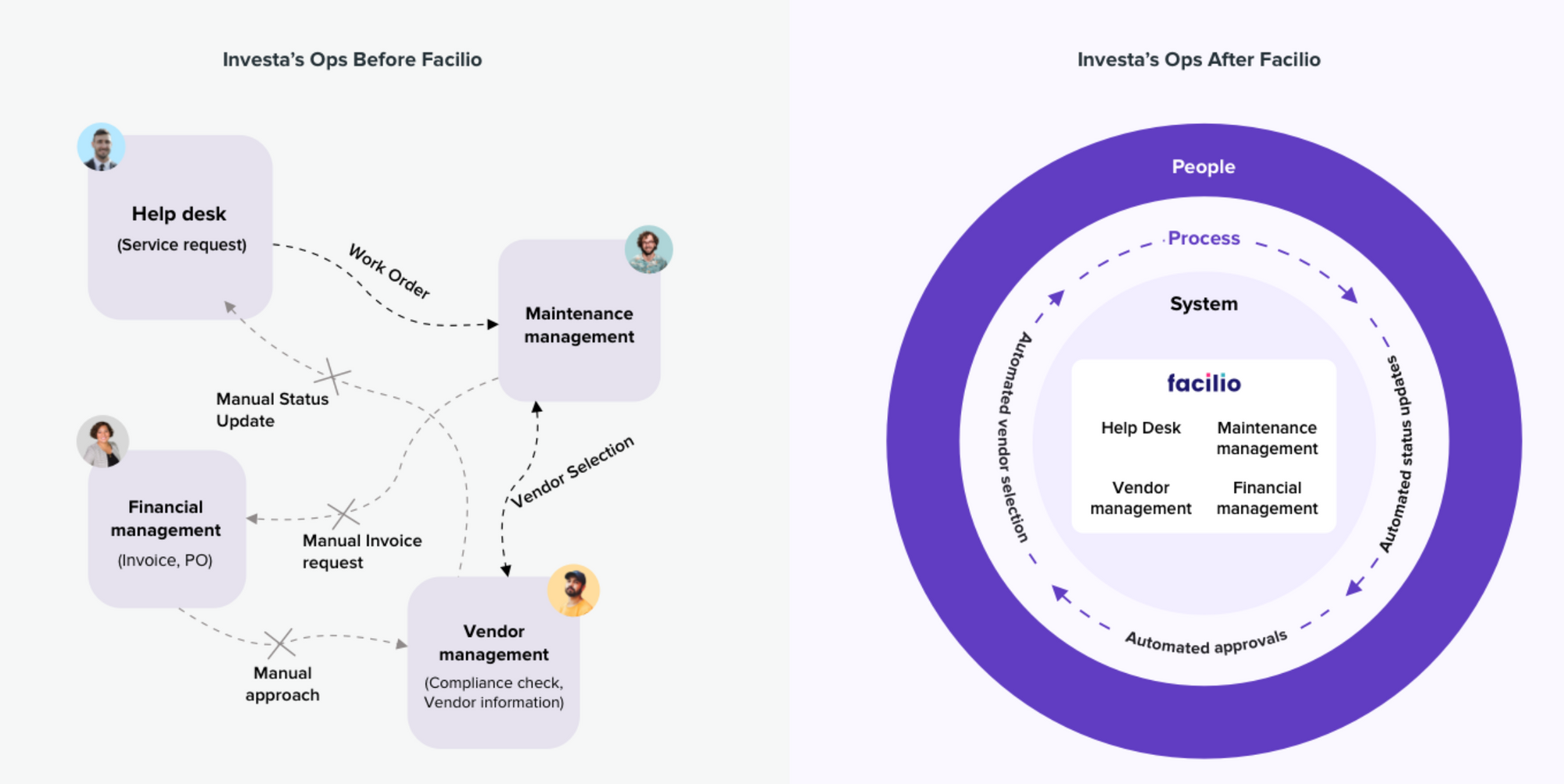CMMS for Campus Facility Management: Boost Efficiency & Sustainability
Key Takeaways
- Traditional FSM tools are inefficient as they lack integration, real-time visibility, and flexibility.
- Connected FSM within a CMMS software streamlining is the solution can help streamline operations and increase efficiency.
- Improved technician management, reduced inventory costs, seamless integration, real-time visibility, and enhanced customer satisfaction are some of the benefits of streamlining facility services management.
- Investing in a campus-wide smart end-to-end facility management software can help prioritize scheduling, visibility, automation, mobile access, security, analytics, and integrations.
Gen Zs and their parents have a checklist for their university of choice. The university must be well known, have great faculty, provide excellent education, have notable alumni, and not in the least - provide a great campus experience.
As a school or university in charge, or a facilities management provider for universities, it is a huge responsibility to ensure a campus is well-maintained, with the day-to-day issues taken care of seamlessly. And in terms of business, provide value and return on their tech investment.
What is lacking in existing campus facilities management?
Very commonly, campuses are dealing with legacy systems and disjointed workflows making maintenance management a lot more complex than it should be.
According to a Gartner article, 38% of organizations rely on manual methods, and 28% have no systems in place for day-to-day facility management operations!
Some of the most common challenges that campuses encounter in their day to day facilities maintenance and management are,
Fragmented systems
Separate software for monitoring HVACs, tools for lighting control, canteen maintenance through emails and calls - managing multiple systems become error-prone and time-consuming, taking away the time for other critical tasks.
Disparate systems also require a lot of manual effort to extract data for various purposes, reducing the accuracy of the data. Campuses are also struggling with accountability issues, gaps in communication and labor-intensive processes.
Dissatisfied staff and students
The Association of Physical Plant Administrators, APPA, conducted a survey of its members earlier this year on the biggest challenges they found at work. Several responses mentioned, “lack of technical personnel for maintenance”, “burnout”, and “retention” among other obstacles.
With multiple tools and processes to track assets, issue work orders, schedule maintenance and track their progress can overwhelm the staff running these operations.
We’ve seen that beyond this, residents and students feel the brunt when work orders are not issued on time, or a service request is missed or the annual maintenance or inspection is past its due date.
Institutions then have to deal with unhappy staff, underperformance of their assets, and dissatisfied people on the campuses. It is a dent to operational costs, time and a reputational risk to the institution.
Increased maintenance costs
We’ve consistently observed that outdated facilities management systems lead to increased maintenance costs. This stems from various reasons: limited functionalities, efficiency levels, the inability to integrate with other systems or newer technologies and so on.
All this leads to reactive maintenance - so which means that the pipe burst in a student accommodation area is fixed only after the pipe burst.
The system is unable to capture the fact that the pipe is old and needed a replacement six months ago. So what would have been a simple pipe replacement, is now a full-fledged repair, and services to mitigate the damage.
Typically HVAC systems, as a result of reactive maintenance, throw up much higher energy bills, stressing the annual budgets. Not only is it cost-inefficient, it is energy and workforce-inefficient as well.
Most campuses are now maturing building structures, and addressing these pressing facilities management challenges will not only make day-to-day operations effective for the workforce, and improve the quality of life on the campus for students, but also improve the lifespan of structures.
Typically, educational institutes don’t have a CaFM inhouse - they don’t even have budgets for one. We need to educate FMs on the importance of having a system inhouse, and help them make a case.
Current state (outsourced and blind): Is relying on FM vendors completely for your campus O&M a wise choice?
The real cost of this gap + making a case for change: Why You Need to Budget for an In-House CaFM: Campus Operations #101
Charge your campus with the power of Connected CMMS
A Connected Computerized Maintenance Management System can empower campus facilities management teams to centrally manage the various components of their institution, swiftly and effectively.
Several organizations like Gartner, Verdantix, International Facility Management Association etc. have published research showing that campuses using integrated facilities management solutions like a connected CMMS have seen reduction in operational costs and overall improvement in the operations, boosting staff morale.
Here are key areas that a connected CMMS impacts uplifting the facilities management in a campus.
Taking care of maintenance, end-to-end
Imagine streamlining the entire maintenance operations on your campus with one platform. A connected CMMS will help you do that.
- So you can catalog all your campus services in one place and with automated workflows tackle all day-to-day activities a lot easier.
- Simplified request tracking, automatic generation and approval of work orders, ensuring the right technician is available at the right time and so on.
- If the CMMS has mobile capabilities that can work offline, technicians can stay productive even without an internet connection.
- Inventory can be better managed with parts available on demand preventing the downtime due to unavailable resources.
Additionally, buying proactively can bring down the costs - buying in bulk, using corporate discounts etc. A big part of the puzzle that can be solved with a connected CMMS is integrating vendor lifecycle management - this can help campuses ensure high-quality services at optimized costs.
For a real-world example of how this can be achieved, we recommend reading the case study "How Dubai's Top Schools Achieved a Breakthrough in Operational and Maintenance Efficiency."
Impeccable asset management
Factoring the number of assets a campus facilities team has to manage, they cannot rely on manual processes for this. And timely, competent asset management becomes an integral part of budget management, and to extend the life of critical assets.
Tools and platforms that can enable teams with real-time data to track asset performance, provide information on asset history, usage patterns, and help them forecast expenses to mitigate unexpected costs are the ones that add real value.
In a recent Deloitte report, notes that predictive maintenance provides a 3X benefit to organizations by limiting the cascading impact of a damaged asset, extending their life and elevating the ROI and empowering the workforce and making better use of their time.
A connected CMMS provides data-driven asset management capabilities for campuses to enhance the reliability of various assets and keep a tight leash on costs.
High visibility through dashboards and reports
Access to all the vital data in one place has been a game changer for campus facilities management teams. The provision to create tailored reports can drive proactive and informed decision-making across the campuses resulting in improved workforce morale, superior optimization of resources and a tangible cost benefit.
A comprehensive reporting ecosystem that we built for one of our customers, The Fortes Education Group in Dubai, has helped them see an increase in operational efficiency and clock in a 90% adherence to SLAs.
The reports provided a detailed tracking of KPIs and productivity analysis, and dashboards were customized such that each team member could access relevant information in real time. Users could access detailed descriptions of service requests, vendor performance, number of maintenance issues, resolution times and much more.
Taking firm steps towards energy efficiency
With a keen focus on building energy efficiency, campuses can actually lead the way in advocating greener and carbon-neutral campuses!
The Sustainability magazine talks about the University of Toronto and how they are taking steps to become climate-positive by 2050!
Connected CMMS can help campuses monitor your campus energy/emissions data in real-time so you can,
- Track, understand, and benchmark energy consumption across your portfolio
- Take predictive action to ensure compliance to sustainability standards, and
- Continuously drive performance improvements

Learn how Melbourne’s renowned university reduced energy costs to fast-track their sustainability goals using Facilio
Final thoughts
A connected CMMS is a present and forward-thinking solution that can transform the way facilities are managed in campuses. It can strengthen your stand as a campus that provides superior experience for students and the workforce, and usher in cost efficiencies. So the campus is on the dot when it comes to facilities management.
With a connected CMMS, you’re not just managing work orders—you’re optimizing them. The system automatically assigns tasks based on the availability, skill set, and location of your technicians, ensuring that the right person is always on the job.
No more playing phone tag or losing track of requests. Everything is streamlined and tracked in real-time.

